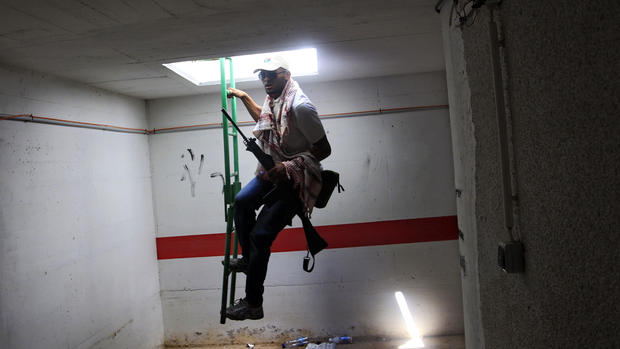Inside Qaddafi's storied, now stormed, compound
Muammar Qaddafi's main military compound, stormed Tuesday by Libyan rebels, was a sprawling blend of barracks, personal living quarters and offices seen as the most defining symbol of the leader's nearly 42-year rule.
Video: Rebels to Qaddafi: "Go to hell"
The Bab al-Azizya military barracks came under heavy attack from NATO aircraft in the months leading up to the battle for Tripoli.
Complete coverage: Anger in the Arab World
As rebels advance, where is Qaddafi?
Libyan rebel forces penetrate Qaddafi's compound
CBS News correspondent Barry Petersen, reporting from inside Qaddafi's compound, said rebel soldiers didn't find anyone after breaching the stronghold through its north gate.
"There was no one from Qaddafi's army; no one was there," a rebel soldier told Petersen.
(At left, listen to Petersen's latest report)
Video: Listen to Petersen's earlier front-line report
"This is something that the people of Libya have never seen," Petersen continued. "This was Qaddafi's playground. Huge, empty fields with beautiful trees, what looks like a mansion or a house ... someone stealing a compact fax machine, taking what they can, stealing what they can, taking away from a man who ruled them for 40-some years."
McCain: Qaddafi's WMDs must be secured
It was surrounded by a high wall fitted with sensors, alarms, and remote-control infrared cameras that constantly scanned the access roads, authors David Blundy and Andrew Lycett write in their book "Gadhafi and the Libyan Revolution." The video was fed back to a bank of television screens in a main security room.
Qaddafi's home and office sat in a bunker designed by West German engineers to withstand massive attack. The leader's wife and family lived in a two-story building, their opulent living room decorated with glass screens, paintings and sofas.
Qaddafi entertained guests in a Bedouin-style tent pitched near two tennis courts about 200 yards from the family home.
Blundy and Lycett describe Bab al-Azizya as "a pleasant place, with the security of a prison but the facilities of a country club."
A cruise missile blasted an administration building in Bab al-Azizya in March, knocking down half the three-story structure early in the campaign of airstrikes against Qaddafi. Months of NATO airstrikes left much of the rest of the compound largely demolished.
The compound was also targeted in a U.S. bombing in April 1986, after Washington held Libya responsible for a blast at a Berlin disco that killed two U.S. servicemen. on Tuesday, one rebel climbed onto a sculpture of a clenched fist crushing a U.S. fighter jet that had been erected after the strike.
Blundy and Lycett describe the compound as dominated by the 100-foot metal skeleton of a communications mast that kept Qaddafi in touch with his senior army officers in Sirte, Benghazi, and the main control center at the oasis town of Jufrah, 125 miles south of Sirte in the middle of the desert.

